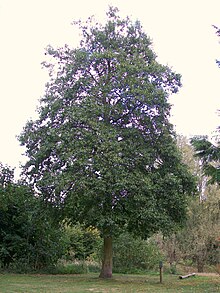Alnus cordata
| Alnus cordata | |
|---|---|

| |
| Scientific classification | |
| Kingdom: | Plantae |
| Clade: | Tracheophytes |
| Clade: | Angiosperms |
| Clade: | Eudicots |
| Clade: | Rosids |
| Order: | Fagales |
| Family: | Betulaceae |
| Genus: | Alnus |
| Subgenus: | Alnus subg. Alnus |
| Species: | A. cordata
|
| Binomial name | |
| Alnus cordata (Loisel.) Duby
| |

| |
| Distribution map | |
| Synonyms[1] | |
| |
Alnus cordata, the Italian alder,[1][2] is a tree or shrub species belonging to the family Betulaceae, and native to the southern Apennine Mountains (Campania, Basilicata and Calabria, mainly on western mountain sides) and the north-eastern mountains of Corsica.[3] It has been introduced in Sicily and Sardinia, and more recently in Central-Northern Italy,[4][5][6] other European countries (France, Belgium, Spain, Azores, United Kingdom)[7] and extra-European countries (Chile, New Zealand),[4] where it has become naturalised.
Description[]
It is a medium-sized tree growing up to 25 m (80 feet) tall[8] (exceptionally to 28 m or 90 feet), with a trunk up to 70–100 centimetres (30–40 in) in diameter. The leaves are deciduous but with a very long season in leaf, from April to December in the Northern Hemisphere; they are alternate, cordate (heart-shaped), rich glossy green, 5–12 cm (2–4+3⁄4 inches) long, with a finely serrated margin.
The slender cylindrical male catkins are pendulous, reddish and up to 10 cm (4 inches) long;[8] pollination is in early spring, before the leaves emerge. The female catkins are ovoid, when mature in autumn 2–3 cm (3⁄4–1+1⁄8 inches) long and 1.5–2 cm (5⁄8–3⁄4 inch) broad, dark green to brown, hard, woody, and superficially similar to some conifer cones. The small winged seeds disperse through the winter, leaving the old woody, blackish 'cones' on the tree for up to a year after.
Cultivation[]
Like other alders, it is able to improve soil fertility through symbiotic nitrogen fixation with the bacteria Actinomyces alni (Frankia alni).[9] It thrives on much drier soils than most other alders, and grows rapidly even under very unfavourable circumstances, which renders it extremely valuable for landscape planting on difficult sites such as mining spoil heaps and heavily compacted urban sites. It is commonly grown as a windbreak.
Alnus cordata has gained The Royal Horticultural Society's Award of Garden Merit.[10]
Bonsai[]
The Italian Alder makes a medium to large bonsai, a quick grower it responds well to pruning with branches ramifying well and leaf size reducing quite rapidly.[11]
Other uses[]
The tree also produces valuable reddish-orange wood. It breaks down rapidly when exposed to air, but is durable when immersed in water. The timber is used for turning and carving, for moulding, furniture, panelling and plywood.[9]

Foliage and immature male catkins

Female (seed) catkins
References[]
- ^ Jump up to: a b Kew World Checklist of Selected Plant Families
- ^ BSBI List 2007 (xls). Botanical Society of Britain and Ireland. Archived from the original (xls) on 26 June 2015. Retrieved 17 October 2014.
- ^ Gamisans, J. (1983). "L'Aulne à feuilles en coeur Alnus cordata (Loisel.) Loisel. dans son milieu naturel en Corse". Revue forestière française (in French). Nancy: AgroParisTech (3): 187. doi:10.4267/2042/21651. hdl:2042/21651.
- ^ Jump up to: a b Caudullo, G.; Mauri, A. (2016). "Alnus cordata in Europe: distribution, habitat, usage and threats" (PDF). In San-Miguel-Ayanz, J.; de Rigo, D.; Caudullo, G.; Houston Durrant, T.; Mauri, A. (eds.). European Atlas of Forest Tree Species. Luxembourg: Publications Office of the European Union. p. 62.
- ^ Camarda, I. (1982). "Note su alberi e arbusti della Sardegna" (PDF). Bollettino della Società Sarda di Scienze Naturali (in Italian). 21: 323–331.
- ^ Cambria, Salvatore. "Alnus cordata (Loisel.) Duby". Flora e Vegetazione della Sicilia. Retrieved 15 July 2016.
- ^ Shaw, K.; Wilson, B.; Roy, S. (2014). "Alnus cordata. The IUCN Red List of Threatened Species 2014". doi:10.2305/IUCN.UK.2014-3.RLTS.T194657A2356349.en. Cite journal requires
|journal=(help) - ^ Jump up to: a b Rushforth, Keith (1986) [1980]. Bäume [Pocket Guide to Trees] (in German) (2nd ed.). Bern: Hallwag AG. p. 91. ISBN 978-3-444-70130-6.
- ^ Jump up to: a b Ducci, F.; Tani, A. (2009). "Italian alder - Alnus cordata" (PDF). EUFORGEN Technical Guidelines for Conservation and Use. Archived from the original (PDF) on 2016-08-11. Retrieved 2016-10-19.
- ^ "Alnus cordata AGM". The Royal Horticultural Society. Retrieved 14 March 2020.
- ^ D'Cruz, Mark. "Ma-Ke Bonsai Care Guide for Alnus cordata". Ma-Ke Bonsai. Retrieved 2021-02-04.
External links[]
| Wikimedia Commons has media related to Alnus cordata. |
- Alnus cordata - distribution map, genetic conservation units and related resources. European Forest Genetic Resources Programme (EUFORGEN)
- Alnus
- Trees of Europe
- Flora of Albania
- Flora of Corsica
- Flora of Sardinia
- Flora of Sicily
- Plants described in 1810
- Garden plants of Europe
- Plants used in bonsai
- Ornamental trees


